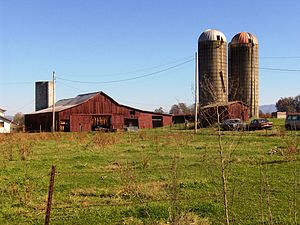Since my move to graduate school, I am learning a lot about Tennessee agriculture. One of them is tobacco. Although tobacco is slowly easing its way out of the immediate area, the red tobacco barns are still standing. These days many of them make good hay barns. During my trip to Houston County a few weeks ago I saw one of these barns smoking. I knew it looked too far along for there to be no excitement around, Turns out the barn is used to fire cure tobacco.
I have only had a look at tobacco fields from the road, and have been told it’s hard work to harvest. Maybe in the next few years, I will have a chance for a closer look. Until then, here are a few Ag Facts about tobacco crops from the USDA ERS.

Tobacco Agriculture Facts
Tobacco has been commercially produced in the United States since 1612. Tobacco production peaked at 2.34 billion pounds in 1963. Between 1963 and 1975, production usually varied from 1.75 to 2.2 billion pounds. Since 1975, however, production has been slowing. The Tobacco Transition Act of 2004 terminated the Federal tobacco program beginning with the 2005 crop.
Tobacco is grown in 21 States. The location of domestic tobacco production has barely changed since the late 1930s when most tobacco production came under the price support and marketing control program. North Carolina and Kentucky are the two largest tobacco-producing States, accounting for about three-fourths of U.S. tobacco production.
Tobacco is one of the top ten U.S. cash crops. The United States is fourth behind China, Brazil, and India in world production and third behind Brazil and China in exports.
As of the January 2010 Annual Crop Production report, U.S. tobacco acreage for 2009 was estimated to have dropped 0.1 percent from 2008 to 354,140 acres. Yields increased 67 pounds per acre overall, reaching 2,325 pounds per acre for all types of tobacco, compared with 2,258 in 2008. Production of all types is estimated at 823 million pounds,3 percent more than the previous year.
Based on January 2006 estimates, 91 percent of U.S. leaf types were used for cigarettes, compared with 93 percent in 2005. There is no longer a marketing quota or price supports for tobacco.
Tennessee Agriculture Facts
Tobacco is a significant contributor to Tennessee agriculture.
- All tobacco acreage for 2009, at 21,600 acres, was down only 200 acres from 2008.
- Burley acreage for 2009 was up 8 percent from 2008. Dark Fire-Cured was down 11 percent to 6,400 acres. Dark Air-Cured was down 25 percent from 2008 at 1,200 acres.
- Burley production for 2009 was 26.9 million pounds, up 9 percent from 2008.
- Tobacco ranked as the eighth leading agricultural commodity produced in the State during 2008. Cash receipts from marketings of tobacco were $80.8 million, or 2.7 percent of the total farm cash receipts generated in 2008.
Have you ever seen or worked with tobacco crops? Are there any tobacco crops left in your area?

